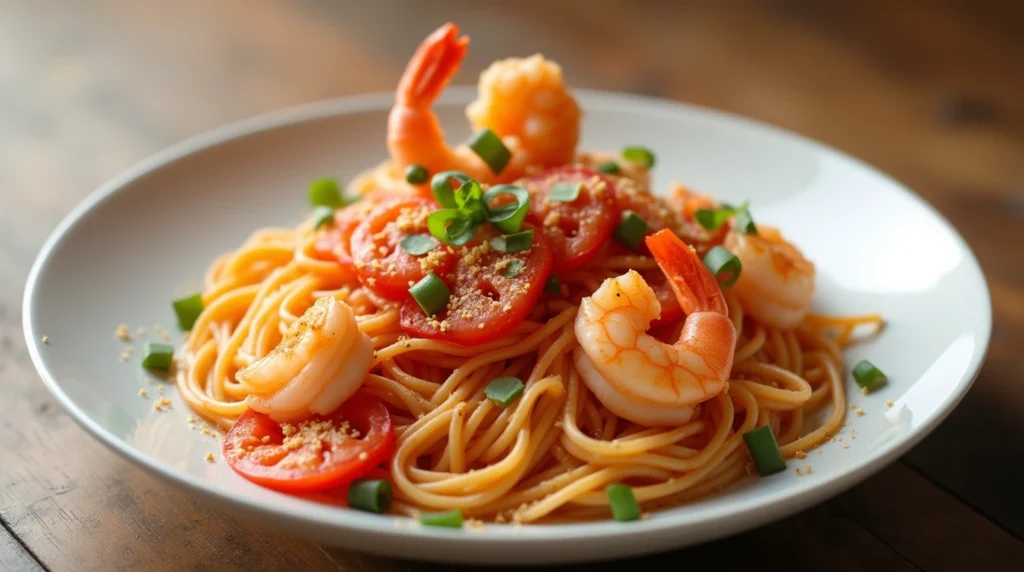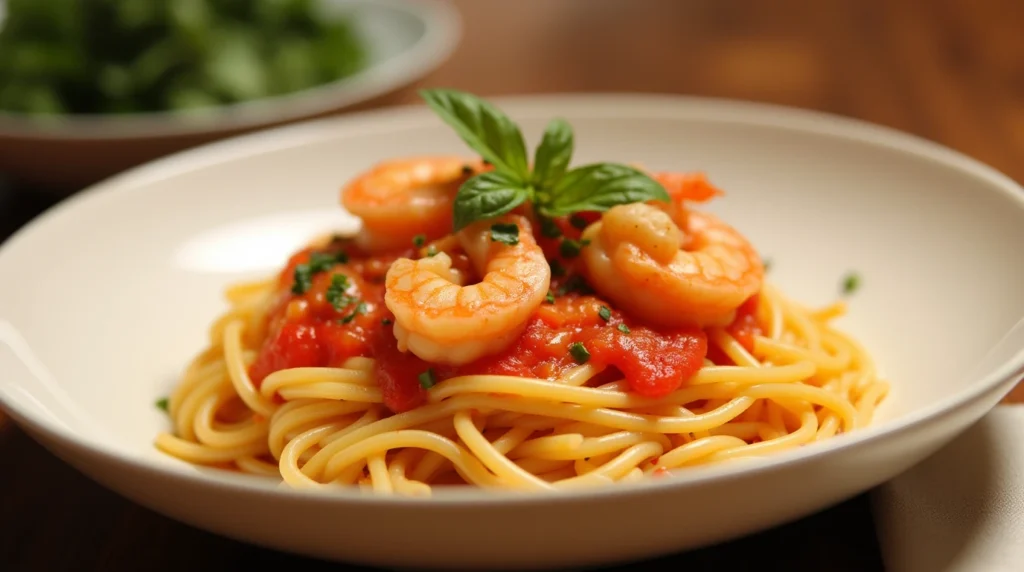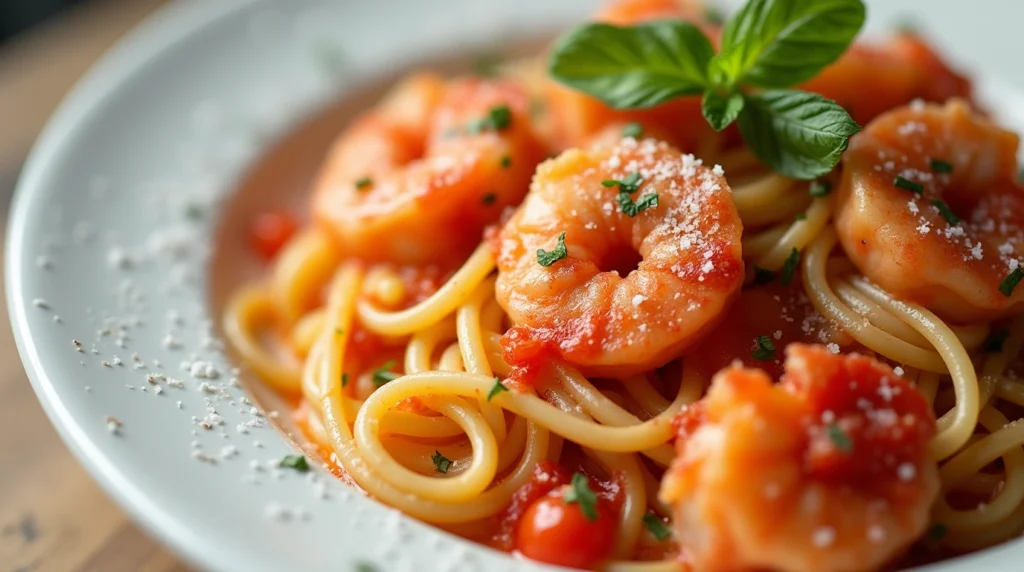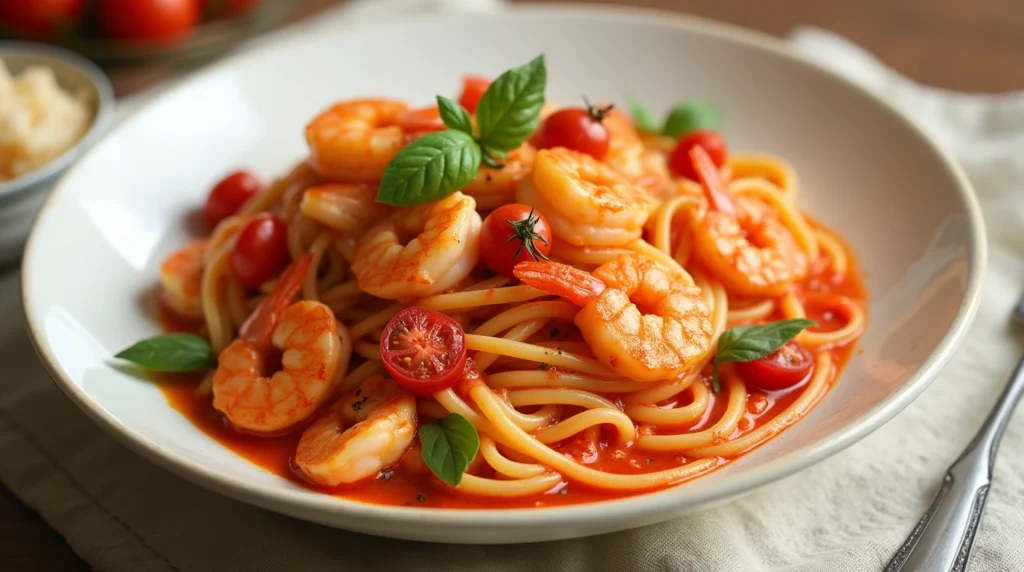Introduction: Why Shrimp Pasta with Fresh Tomato Sauce is the Perfect Dish

- Engage with the Reader – Shrimp pasta tomato:
- Imagine a plate of warm Shrimp pasta tomato, topped with a rich, homemade tomato sauce—doesn’t that sound perfect? This dish is not only delicious, but it’s quick and healthy, making it an ideal dinner choice for busy nights or a cozy weekend meal.
- The combination of fresh tomatoes, succulent shrimp, and flavorful pasta creates an unforgettable experience that you can easily recreate at home. Plus, it’s a dish that feels gourmet without requiring hours of prep or cooking time.
- Why Shrimp Pasta with Tomato Sauce is So Loved:
- It’s a versatile dish that fits a variety of dietary preferences—gluten-free, low-carb, or packed with vegetables. Shrimp pasta with fresh tomato sauce is a fan favorite in Mediterranean cuisine for its fresh ingredients and light yet satisfying nature.
- This dish offers the perfect balance of savory, sweet, and tangy flavors, with each bite transporting you to the coastal regions where seafood is the star of the meal.
Ingredients for the Perfect Shrimp Pasta with Fresh Tomato Sauce
- Shrimp: Choose the Right Shrimp
- Opt for large, peeled, and deveined shrimp for an easy cooking experience. Frozen shrimp work just as well as fresh ones, but make sure to thaw them properly before cooking.
- Look for shrimp labeled as wild-caught for a more sustainable choice and superior flavor.
- Fresh Tomatoes: Why Fresh is Best
- Fresh, vine-ripened tomatoes are key to creating a rich, flavorful sauce. Use Roma tomatoes or plum tomatoes for the perfect texture and taste.
- Fresh tomatoes create a natural, sweet sauce that canned varieties just can’t replicate. Pair them with garlic and olive oil to enhance the flavors further.
- Pasta Options: Pairing the Perfect Pasta
- The best pasta for shrimp and tomato sauce? Consider spaghetti, linguine, or fettuccine—all great options that will hold the sauce and shrimp beautifully.
- Whole wheat pasta or gluten-free pasta are excellent alternatives if you’re looking for healthier or dietary-friendly options.
- Other Essentials: A Flavorful Base
- Olive oil and garlic are a must to create a fragrant, savory base for the tomato sauce.
- Fresh basil and Parmesan cheese are added at the end for a pop of color and rich flavor.
- A splash of lemon and red pepper flakes can add a zesty, spicy kick to round out the dish.
How to Prepare Fresh Tomato Sauce for Shrimp Pasta
- Step 1: Cooking the Tomatoes
- Start by sautéing garlic in olive oil until fragrant, then add the diced fresh tomatoes.
- Allow the tomatoes to break down and release their juices. You may need to add a splash of water or broth to help them cook down into a rich sauce.
- Step 2: Flavoring the Sauce
- Add a pinch of salt, freshly ground black pepper, and red pepper flakes to taste. Adjust the heat to your preference.
- Chop fresh basil and stir it in to add a refreshing note to the sauce, giving it a burst of freshness.
- Step 3: Simmering for Perfection
- Let the sauce simmer on low heat for about 20 minutes, stirring occasionally. This allows the flavors to meld together and thicken.
- If the sauce becomes too thick, add a bit more olive oil or pasta water to reach the desired consistency.
Cooking the Shrimp to Perfection
- Step 1: Seasoning the Shrimp
- Toss the shrimp in a little olive oil, salt, pepper, and fresh lemon juice to bring out their natural sweetness.
- You can add minced garlic and herbs like thyme or parsley for extra flavor if desired.
- Step 2: Perfectly Cooking the Shrimp
- Heat a pan over medium-high heat and cook the shrimp for 2-3 minutes per side, until they’re pink and opaque. Avoid overcooking, as shrimp can become rubbery.
- Once cooked, set the shrimp aside, and don’t forget to save any flavorful juices left in the pan for added flavor.
- Step 3: Adding Shrimp to the Sauce
- Once your tomato sauce is ready, gently add the cooked shrimp and stir to combine. Allow the shrimp to simmer in the sauce for an extra 2-3 minutes to absorb the flavors.
Putting It All Together: Combining Shrimp and Tomato Sauce with Pasta
- Step 1: Cooking the Pasta
- Cook the pasta according to package instructions until it’s al dente. Save a cup of pasta water before draining.
- This starchy water can be used to adjust the consistency of the sauce if needed.
- Step 2: Tossing the Pasta
- Combine the cooked pasta with the shrimp and tomato sauce. Use tongs to toss everything together, ensuring the pasta is evenly coated with the sauce.
- Add a bit of pasta water to help the sauce cling to the pasta and achieve a silky texture.
- Step 3: Serving Suggestions
- Garnish with fresh basil leaves, a sprinkle of grated Parmesan, and a dash of red pepper flakes for some extra heat.
- Serve with a side of crusty bread or a simple green salad for a complete meal.
Tips for Making the Best Shrimp Pasta with Fresh Tomato Sauce
- Customize Your Dish: Add Vegetables or Other Seafood
- Feel free to add spinach, zucchini, or mushrooms to the sauce for an extra layer of flavor and texture.
- You can also try using scallops, clams, or even lobster to elevate the dish.
- Make it Spicy: Adjusting the Heat
- For those who love a little heat, add fresh chili or more red pepper flakes to bring up the spice level.
- A dash of hot sauce or a sprinkle of cayenne pepper can also enhance the dish’s warmth.

Shrimp Pasta with Fresh Tomato Sauce Variations and Customizations
- Adding More Vegetables for a Healthier Dish:
- For those looking to increase their vegetable intake, you can easily incorporate a variety of veggies into the dish. Consider adding spinach, zucchini, yellow squash, or artichokes for extra nutrition and color.
- These veggies also absorb the sauce, giving each bite a more complex and satisfying flavor profile. Sauté them in olive oil before adding the tomatoes to make them soft and flavorful.
- Turning it into a Pesto Shrimp Pasta:
- Add a twist by incorporating pesto into your shrimp pasta. Prepare the fresh tomato sauce as usual, then fold in a couple of tablespoons of pesto before tossing with the pasta.
- This will add a rich, herby, and slightly nutty flavor that pairs beautifully with the shrimp and tomatoes.
- Shrimp Pasta with Lemon and Garlic Butter:
- If you want to switch up the flavor, make a lemon garlic butter sauce to complement your shrimp pasta.
- In a pan, melt butter and cook minced garlic until fragrant. Squeeze in some fresh lemon juice, add the shrimp, and let it cook until golden. Toss the shrimp and sauce with pasta and fresh tomato sauce for a buttery, zesty take on the dish.
- Making it Low-Carb:
- For a lower-carb alternative, swap out traditional pasta with zucchini noodles or spaghetti squash. These vegetables absorb the fresh tomato sauce wonderfully while cutting down on carbs.
- Cauliflower rice or a cauliflower-based pasta is another great option to keep the dish light and healthy without compromising on flavor.
How to Make the Perfect Shrimp Pasta with Fresh Tomato Sauce Ahead of Time
- Can I Prep This Dish in Advance?
- Yes! You can prep many parts of the shrimp pasta in advance to make dinner a breeze.
- Shrimp: Marinate the shrimp in olive oil, lemon, garlic, and seasoning, then store them in the fridge for up to 2 hours before cooking.
- Tomato Sauce: You can cook the fresh tomato sauce up to a day ahead of time. Let it cool, and then store it in an airtight container in the fridge. When you’re ready to serve, simply heat it up and add the shrimp and pasta.
- Freezing the Dish:
- Shrimp Pasta: If you want to store leftovers, this dish freezes well. Let it cool completely, then store in an airtight container. It can stay in the freezer for up to 2 months. Reheat gently on the stovetop or in the microwave.
- Tomato Sauce: The tomato sauce can be frozen separately, so you can use it again in future meals. Simply let it cool, transfer it to a freezer-safe container, and freeze for up to 3 months.
Health Benefits of Shrimp Pasta with Fresh Tomato Sauce
- Packed with Lean Protein:
- Shrimp is a fantastic source of lean protein, which is essential for muscle growth, repair, and overall body function. This makes shrimp pasta a great option for those trying to maintain or build muscle mass.
- Rich in Antioxidants:
- Tomatoes are a powerhouse of antioxidants like lycopene, which is linked to heart health and cancer prevention. Fresh tomatoes, when cooked, actually release more lycopene than raw tomatoes, making this dish a powerful antioxidant-rich meal.
- Healthy Fats from Olive Oil:
- Olive oil is a heart-healthy fat that provides monounsaturated fats, which are good for maintaining cholesterol levels. It also contains anti-inflammatory properties that benefit overall health.
- Low in Carbs (when using alternatives):
- When paired with zucchini noodles or a cauliflower-based pasta, this dish becomes a low-carb option that still delivers on flavor and texture. This makes it ideal for those following keto, paleo, or low-carb diets.
Common Mistakes to Avoid When Making Shrimp Pasta with Fresh Tomato Sauce

- Overcooking the Shrimp:
- One of the most common mistakes when making shrimp pasta is overcooking the shrimp. Shrimp cook quickly, and overcooking can make them tough and rubbery. To avoid this, cook the shrimp for 2-3 minutes per side, or until they turn pink and opaque. Remove them from the heat immediately to preserve their tenderness.
- Using Canned Tomatoes Instead of Fresh:
- While canned tomatoes are convenient, fresh tomatoes provide a much brighter, more vibrant flavor for your tomato sauce. When possible, opt for vine-ripened tomatoes for the best flavor. If fresh tomatoes aren’t available, look for high-quality canned tomatoes with no added preservatives.
- Not Seasoning the Sauce Enough:
- Tomato sauces need adequate seasoning to bring out their natural flavors. Don’t forget to add a pinch of salt and pepper, along with a little sugar to balance the acidity of the tomatoes. Fresh herbs like basil or thyme can also enhance the flavor profile, giving it a more aromatic, fresh taste.
- Using the Wrong Pasta:
- While most pasta types work well with shrimp, spaghetti, linguine, or fettuccine are generally the best choices. They have the right surface area to capture the sauce and shrimp. Heavier pasta shapes like penne or rigatoni can feel too bulky and might overwhelm the shrimp and delicate tomato sauce.

Frequently Asked Questions (FAQ)
Here are some common questions readers might have about making shrimp pasta with fresh tomato sauce. These answers will help provide additional value to your readers, boost engagement, and improve SEO performance.
Q1: Can I use frozen shrimp for this shrimp pasta recipe?
A1: Yes, you can absolutely use frozen shrimp for this recipe! Just make sure to thaw the shrimp properly before cooking to ensure they cook evenly. You can thaw them overnight in the fridge or quickly thaw them by placing the shrimp in a colander under cold running water for about 5-10 minutes.
Q2: What is the best type of pasta to use for shrimp pasta with fresh tomato sauce?
A2: The best type of pasta depends on your personal preference, but classic spaghetti, linguine, or fettuccine are all great options. Long pasta shapes help to better hold the sauce, while shorter pasta shapes like penne or rigatoni will also work if that’s what you prefer.
Q3: Can I make the tomato sauce in advance?
A3: Yes! The tomato sauce can be made a day ahead of time and stored in the fridge. In fact, letting the sauce sit overnight allows the flavors to meld even more, making it even more delicious. Just reheat the sauce gently before adding the shrimp and pasta.
Q4: How do I prevent shrimp from overcooking in the pasta?
A4: Shrimp cook very quickly, so it’s important to keep an eye on them. They should be cooked until they are pink and opaque. Overcooking shrimp can lead to a rubbery texture, so once they turn pink and curl slightly, remove them from the heat immediately.
Q5: Can I add vegetables to the shrimp pasta with fresh tomato sauce?
A5: Absolutely! Adding vegetables to your shrimp pasta is a great way to boost the nutritional value and add more flavor. You can add spinach, zucchini, or bell peppers to the sauce as it simmers, or sauté some broccoli or asparagus to serve alongside.
Q6: How can I make the shrimp pasta spicier?
A6: If you prefer a spicier kick, simply add red pepper flakes to the tomato sauce while it simmers. You can also add a chopped jalapeño or fresh chili for extra heat. If you’re looking for a really fiery pasta, drizzle a bit of chili oil on top before serving.
Q7: Can I use canned tomatoes instead of fresh ones?
A7: While fresh tomatoes give the best flavor, you can use canned tomatoes in a pinch. Look for whole peeled tomatoes or crushed tomatoes for the most authentic taste. Just make sure to cook the sauce long enough to develop the flavors.
Q8: How do I store leftovers?
A8: Leftovers can be stored in an airtight container in the refrigerator for up to 2-3 days. Simply reheat in a pan on low heat or microwave until warmed through. You may want to add a splash of water or olive oil to keep the pasta from drying out.
Q9: What are some other seafood alternatives to shrimp for this recipe?
A9: If you’re not a fan of shrimp, you can substitute with other seafood like scallops, lobster, or white fish (e.g., cod or tilapia). Keep in mind that the cooking times for these alternatives may differ slightly.
H2: Final Thoughts
Make Your Shrimp Pasta with Fresh Tomato Sauce Your Own
This shrimp pasta with fresh tomato sauce recipe is easy to make, flavorful, and versatile. By combining tender shrimp, rich tomato sauce, and perfectly cooked pasta, you create a dish that’s perfect for any occasion. Whether you stick to the classic recipe or get creative with some variations, this dish is sure to impress.
Remember, cooking is all about experimenting with flavors and making the recipe your own. Don’t hesitate to adjust the spice levels, add extra veggies, or even try different types of pasta. Most importantly, have fun in the kitchen and enjoy the delicious results!
